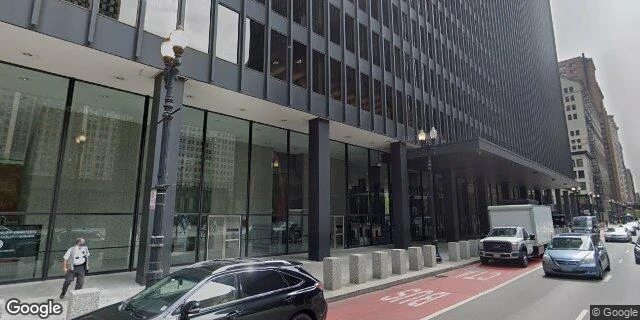IL0000FC-CHICAGO FEDERAL CTR
🚩
Chicago Building ID: 101757

Attribution: © Google 2025
Building Info
- Square Footage
- 3,176,860 sqft#6 Largest#1 Largest of Mixed Use Properties26x median124,364 sqft9x median Mixed Use Property367,703 sqft
- Built
- 1975
- Primary Property Type
- Mixed Use Property
- Community Area
- Loop
- Ward
- 34
-
Chicago Energy Rating
- 3.5 / 4
-
Energy Star Score
- 74 / 100
- Owner
2023 Report Card
Debug Full Grade Data
- AvgPercentileLetterGrade: B
- AvgPercentileGrade: 70.6026551658936
- GHGIntensityLetterGrade: B
- GHGIntensityPercentileGrade: 62.75272161741835
- EnergyMixLetterGrade: B
- EnergyMixWeightedPctSum: 47.21357533681762
- EnergyMixPercentileGrade: 73.06573589296103
- SubmittedRecordsLetterGrade: A
- MissingRecordsCount: 0.0
- SubmittedRecordsPercentileGrade: 100.0
Emissions & Energy Information for 2023
- Greenhouse Gas Intensity B
- 5.5 kg CO2e / sqft#5 Lowest of Mixed Use Properties 🏆Lower than 64% of all buildings0.9x median6.2 kg CO2e / sqft0.8x median Mixed Use Property7.3 kg CO2e / sqft
- Total Greenhouse Gas Emissions
- 17,418 tons CO2e#20 Highest in Chicago* 🚩#4 Highest of Mixed Use Properties 🚨21x median841.4 tons CO2e6x median Mixed Use Property2,780.3 tons CO2e
Years Reported
6/10
A

2014
2015
2016
2017
2018
2019
2020
2021
2022
2023
Energy Breakdown for IL0000FC-CHICAGO FEDERAL CTR
- Fossil Gas Use (aka Natural Gas)
- 97,712,715 kBtuEst. Gas Bill: $1,165,000 for 2023**#16 Highest in Chicago* 🚩#2 Highest of Mixed Use Properties 🚨18x median5,517,828 kBtu8x median Mixed Use Property11,866,510.8 kBtu
- Electricity Use
- 87,396,839 kBtuEst. Electric Bill: $3,663,000 for 2023**#22 Highest in Chicago* 🚩#5 Highest of Mixed Use Properties 🚨24x median3,580,332.6 kBtu6x median Mixed Use Property13,547,528.5 kBtu
Energy Mix B
Total Energy Use: 185,109,555 kBTU
Scan To Learn More
https://electrifychicago.net/building/i-l0000-fc-chicago-federal-ctr/
View Extra Technical & Historic Info
- Source Energy Usage Intensity
- Not Reported
This data was not reported for this building this year, which likely means a value of zero for this field.
- Site Energy Usage Intensity
- Not Reported
This data was not reported for this building this year, which likely means a value of zero for this field.
Full Historical Data Table for IL0000FC-CHICAGO FEDERAL CTR
| Year |
Overall Grade |
Emissions Intensity Sub-Grade |
Energy Mix Sub-Grade |
Reporting Mix Sub-Grade | GHG Intensity kg CO2e / sqft | GHG Emissions metric tons CO2e | Energy Mix | Electricity Use kBTU | Fossil Gas Use kBTU |
District Chilled Water Use kBTU | Source EUI kBTU / sqft | Floor Area sqft |
Chicago Energy Rating |
Energy Star Score |
|---|---|---|---|---|---|---|---|---|---|---|---|---|---|---|
| 2014 | - | 87,741,252 | 113,327,886 | 34,628,436 | 135 | 3,177,981 | - | 90.0 | ||||||
| 2015 | - | 87,092,017 | 97,391,874 | 39,515,812 | 130.7 | 3,176,860 | - | 90.0 | ||||||
| 2016 | B | B | B | A | 7.3 | 23,271 | 52%Electricity 48%Fossil Gas 0%Other | 100,136,161 | 90,635,999 | - | 128.9 | 3,176,860 | - | 87.0 |
| 2017 | B | B | B | A | 7.1 | 22,412 | 48%Electricity 52%Fossil Gas 0%Other | 92,744,745 | 99,119,876 | - | 124.4 | 3,176,860 | - | 88.0 |
| 2018 | B | B | B | A | 6.5 | 20,782 | 47%Electricity 53%Fossil Gas 0%Other | 91,986,701 | 103,164,044 | - | 115.2 | 3,176,860 | 3.5 | 65.0 |
| 2019 | - | 94,861,721 | 111,969,113 | - | 3,176,860 | 3.0 | 70.0 | |||||||
| 2020 | B | B | B | A | 5.8 | 18,412 | 45%Electricity 55%Fossil Gas 0%Other | 83,287,238 | 101,934,238 | - | 107.1 | 3,176,860 | 4.0 | 76.0 |
| 2021 | B | B | B | A | 5.8 | 18,419 | 45%Electricity 55%Fossil Gas 0%Other | 88,752,432 | 108,131,429 | - | 114 | 3,176,860 | 2.0 | - |
| 2022 | - | - | - | - | 3,176,860 | 0.0 | - | |||||||
| 2023 | B | B | B | A | 5.5 | 17,418 | 47%Electricity 53%Fossil Gas 0%Other | 87,396,839 | 97,712,716 | - | 109.3 | 3,176,860 | 3.5 | 74.0 |
* Note on Rankings: Rankings and medians are among included buildings, which are those who reported under the Chicago Energy Benchmarking Ordinance for the year 2023, which only applies to buildings over 50,000 square feet.
** Note on Bill Estimates:
Estimates for gas and electric bills are based on average electric and
gas retail prices for Chicago in 2021 and
are rounded. We expect large buildings would negotiate lower rates with
utilities, but these estimates serve as an upper bound of cost and help
understand the volume of energy a building is used by comparing it to
your own energy bills! See our
Chicago Gas & Electric Costs Source
for the original statistics.
Data Source:
Chicago Energy Benchmarking Data